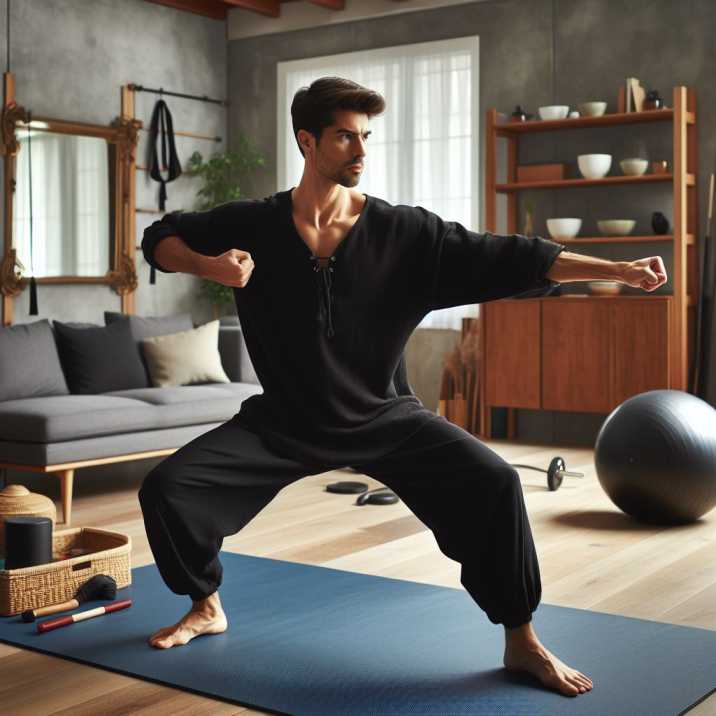Introduction:
Table of Contents
Are you fascinated by the grace and power of Kung Fu, but unsure where to start? Whether you’re a complete beginner or have some experience in martial arts, learning Kung Fu at home is not only possible but also incredibly rewarding. In this comprehensive guide, we’ll explore various methods, techniques, and resources to help you kick-start your Kung Fu journey from the comfort of your living room.
Understanding the Basics Learning Kung Fu at Home
Before diving into training, it’s crucial to understand the fundamental principles and philosophy behind Kung Fu. Originating from China, Kung Fu is not just about physical combat but also encompasses mental discipline, self-awareness, and harmony with nature. By grasping these basics, you’ll develop a deeper appreciation for the art and approach your training with the right mindset.
Setting Up Your Training Space
Creating a conducive environment for practicing Kung Fu at home is essential for effective learning. Find a spacious area free from clutter and distractions where you can move freely without any hindrance. Clear out furniture or obstacles that may obstruct your movements, and consider investing in a quality martial arts mat to provide cushioning and support during training sessions.

Learning Basic Stances and Postures
Mastering proper stances and postures forms the foundation of Kung Fu practice. Begin by familiarizing yourself with essential stances such as Horse Stance, Bow Stance, and Cat Stance. Focus on maintaining balance, stability, and proper alignment of the body while transitioning between different postures. Practice these basic stances regularly to build strength, flexibility, and coordination.
Practicing Basic Techniques
Once you’ve developed a solid understanding of stances and postures, it’s time to delve into basic techniques. Start with fundamental movements such as punches, kicks, blocks, and strikes. Pay close attention to correct form and execution, focusing on precision and control rather than speed and power initially. Practice each technique slowly and deliberately, gradually increasing speed and intensity as you gain proficiency.
Incorporating Strength and Conditioning
Strength and conditioning play a crucial role in Kung Fu training, helping to improve overall fitness and enhance martial arts performance. Incorporate exercises such as bodyweight workouts, cardiovascular training, and flexibility drills into your routine to build strength, endurance, and agility. Focus on developing a balanced fitness regimen that targets different muscle groups and enhances overall physical capabilities.
Exploring Online Resources and Tutorials
In the digital age, there is a wealth of online resources and tutorials available for learning Kung Fu at home. Explore reputable websites, instructional videos, and online courses hosted by experienced martial artists and Kung Fu masters. Look for comprehensive tutorials that cover a wide range of techniques, drills, and training methods suitable for beginners.
Seeking Guidance from Qualified Instructors
While learning Kung Fu at home is feasible, nothing beats the guidance and feedback of a qualified instructor. Consider enrolling in virtual martial arts classes or private lessons conducted by certified Kung Fu instructors. Virtual platforms offer interactive sessions where you can receive personalized instruction, corrections, and guidance tailored to your individual needs and progress.
Practicing Mindfulness and Meditation
In addition to physical training, Kung Fu emphasizes the importance of mental discipline and inner strength. Incorporate mindfulness and meditation practices into your daily routine to cultivate mental clarity, focus, and resilience. Take time to quiet your mind, center your thoughts, and visualize your goals and progress in your Kung Fu journey.
Setting Realistic Goals and Tracking Progress
As you embark on your Kung Fu journey, it’s essential to set realistic goals and track your progress along the way. Establish short-term and long-term objectives that align with your skill level and aspirations, whether it’s mastering a specific technique, improving flexibility, or advancing to a higher belt rank. Keep a training journal to record your achievements, challenges, and areas for improvement, allowing you to track your growth and stay motivated.
Staying Consistent and Persistent
Consistency and persistence are key to success in learning Kung Fu or any martial art. Make a commitment to practice regularly, even if it’s just a few minutes each day. Consistent training not only reinforces muscle memory and skill development but also fosters discipline, dedication, and resilience. Embrace challenges and setbacks as opportunities for growth, and maintain a positive attitude throughout your journey.
Table of information summarizing key points
| Topic | Information |
|---|---|
| Understanding the Basics | Kung Fu originated from China and encompasses mental discipline, self-awareness, and combat. |
| Setting Up Training Space | Find a spacious, clutter-free area at home for practice, and consider using a martial arts mat. |
| Learning Basic Stances | Essential stances include Horse Stance, Bow Stance, and Cat Stance for balance and stability. |
| Practicing Basic Techniques | Focus on punches, kicks, blocks, and strikes, emphasizing correct form and controlled movements. |
| Strength and Conditioning | Incorporate bodyweight exercises, cardio, and flexibility drills to enhance overall fitness. |
| Online Resources | Explore reputable websites and instructional videos for comprehensive tutorials and guidance. |
| Seeking Guidance | Consider virtual martial arts classes or private lessons with certified Kung Fu instructors. |
| Mindfulness and Meditation | Practice mindfulness and meditation to cultivate mental clarity, focus, and inner strength. |
| Setting Goals | Establish realistic short-term and long-term goals aligned with your skill level and aspirations. |
| Consistency and Persistence | Commit to regular practice, embracing challenges as opportunities for growth and improvement. |
This table provides a concise overview of the key aspects involved in starting learning Kung Fu at home, serving as a handy reference for beginners.
Conclusion:
Embarking on the journey of learning Kung Fu at home is an empowering and fulfilling experience that requires dedication, discipline, and a genuine passion for the martial arts. By understanding the basics, creating a conducive training environment, and incorporating a balanced approach to physical and mental conditioning, you can embark on a transformative journey of self-discovery and mastery. Whether you’re aiming to improve fitness, build self-confidence, or delve deeper into the ancient art of Kung Fu, remember that every step you take brings you closer to realizing your full potential as a martial artist.
(FAQs)
1. Can I learn Kung Fu at home without any prior experience?
- Yes, it’s possible to start learning Kung Fu at home as a beginner. Many online resources and tutorials cater to beginners, providing step-by-step instructions and demonstrations of basic techniques. However, it’s essential to approach your training with dedication, discipline, and a willingness to learn.
2. How often should I practice Kung Fu at home to see progress?
- The frequency of practice depends on your schedule and commitment level. Aim to practice Kung Fu at least a few times a week, dedicating at least 20-30 minutes to each session. Consistent practice is key to seeing progress, so try to establish a regular training routine that fits into your daily life.
3. What equipment do I need for practicing Kung Fu at home?
- While you can start with minimal equipment, having a few essentials can enhance your training experience. Consider investing in a quality martial arts mat for cushioning and support, comfortable workout attire, and perhaps basic training gear like gloves and pads for partner drills. Additionally, having access to online resources and tutorials is beneficial for learning new techniques and refining your skills.
4. How long does it take to become proficient in Kung Fu?
- The time it takes to become proficient in Kung Fu varies depending on various factors such as individual aptitude, dedication to practice, and the complexity of the style being learned. While some may show progress more quickly, achieving proficiency typically requires consistent training over months or even years. Remember that mastery in martial arts is a continuous journey, and progress comes with dedicated effort and perseverance.
5. Are there any online communities or forums for Kung Fu enthusiasts to connect and share experiences?
- Yes, there are several online communities and forums dedicated to Kung Fu enthusiasts where practitioners can connect, share experiences, and seek advice from fellow martial artists. Websites, social media groups, and forums specifically cater to Kung Fu practitioners, providing a platform for discussions, sharing training tips, and even finding training partners or instructors. Engaging with such communities can be valuable for networking, learning, and staying motivated in your Kung Fu journey.


